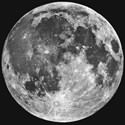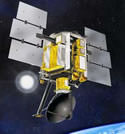
Image credit: NASA
The full moon on February 27 is going to be the brightest one of 2002. The moon’s orbit isn’t a perfect circle; over the course of its 28-day trip around the Earth, its distance varies from 406,700 km to 356,400. And today’s full moon happens to coincide with the closest point of that orbit, making it 20% brighter than an average full moon.
A pale ray of light shines through the bedroom window. In the distance, something howls. Eyes open. The clock ticks, it’s 2 a.m.. You’re wide awake — roused by a bright full Moon.
Don’t be surprised if this soon happens to you. The Moon will become full on Feb. 27th. It happens every 29.5 days, yet this full Moon is special: It’s the biggest and brightest of the year.
“Not all full Moons are alike,” says astronomy professor George Lebo. “Sometimes pollution or volcanic ash shades them with interesting colors. Sometimes haloes form around them — a result of ice crystals in the air.”
“This full Moon is unique in another way,” he says. “It will be closer to Earth than usual.”
Right: The apparent size of the Moon at perigee (top) and apogee (bottom).
“The moon’s orbit around our planet is not a perfect circle,” Lebo explains. “It’s an ellipse.” At one end of the ellipse (called apogee) the Moon lies 406,700 km from Earth. At the other end (called perigee) the Moon is only 356,400 km away — a difference of 50 thousand km!
When the Moon is full on Feb. 27th it will be near perigee — close to Earth. As a result the Moon will appear 9% wider than normal and shine 20% brighter.
The extra moonlight is caused, in part, by the Moon’s nearness to Earth. But that’s not all. The Sun is closer to Earth, too. Lebo explains: “Every year during northern winter, Earth is about 1.6% closer to the Sun than normal. (Like the Moon’s orbit around Earth, Earth’s orbit around the Sun is elliptical. Our closest approach to the Sun is called perihelion.) The Moon reflects sunlight, so the Moon is brighter during that time.”
This effect should not to be confused with the famous “Moon Illusion” — a trick of the eye that makes Moons rising near the horizon appear swollen. The nearby full Moon this week really will be bigger and brighter.
Below: The brightness of full Moons in 2002 relative to that of an average full Moon. In Feb., for example, the Moon will be 20% brighter than average; in Aug. it will be 12% dimmer. These values take into account the varying distances of the Moon from Earth and of the Earth from the Sun.
The first three full Moons of 2002 are all brighter-than-average. All three happen when the Moon is near perigee, and when Earth is relatively close to the Sun. Full Moons later this year will be smaller and dimmer by comparison. For example, August’s full Moon — an “apogee Moon” — will be about one-third dimmer than February’s.
But will anyone notice the difference?
“The human eye can easily discern a 20 or 30% difference in the brightness of two similar light sources,” says eye doctor Stuart Hiroyasu. By that reckoning, a sky watcher could tell the difference between a bright perigee Moon and a dimmer apogee Moon. But the two Moons would have to be side by side to effect the comparison — not likely except in a science fiction movie!
Below: Our Moon’s appearance changes nightly. This time-lapse sequence (Credit: Ant?nio Cidad?o) shows what our Moon looks like during a lunation, a complete lunar cycle. [more]
Even the dimmest full Moons are very bright, notes Lebo. They outshine Sirius, the brightest star in the sky, by twenty-five thousand times. They cast shadows, and provide enough light to read by. “There’s really no such thing as a faint full Moon. It’s all relative.”
Nevertheless, some sky watchers will sense that this Moon has something “extra” — particularly northerners. Many northern landscapes in February remain covered with snow. Snow reflects about two-thirds of the light that hits it, while bare ground reflects only about 15%. A snowy moonlit landscape always seems remarkably bright.
Perigee, perihelion, snowy terrain — they all add up to a big dose of Moonlight. Can you tell the difference? There’s only one way to find out: Go outside and look!
Original Source: NASA Science Story

